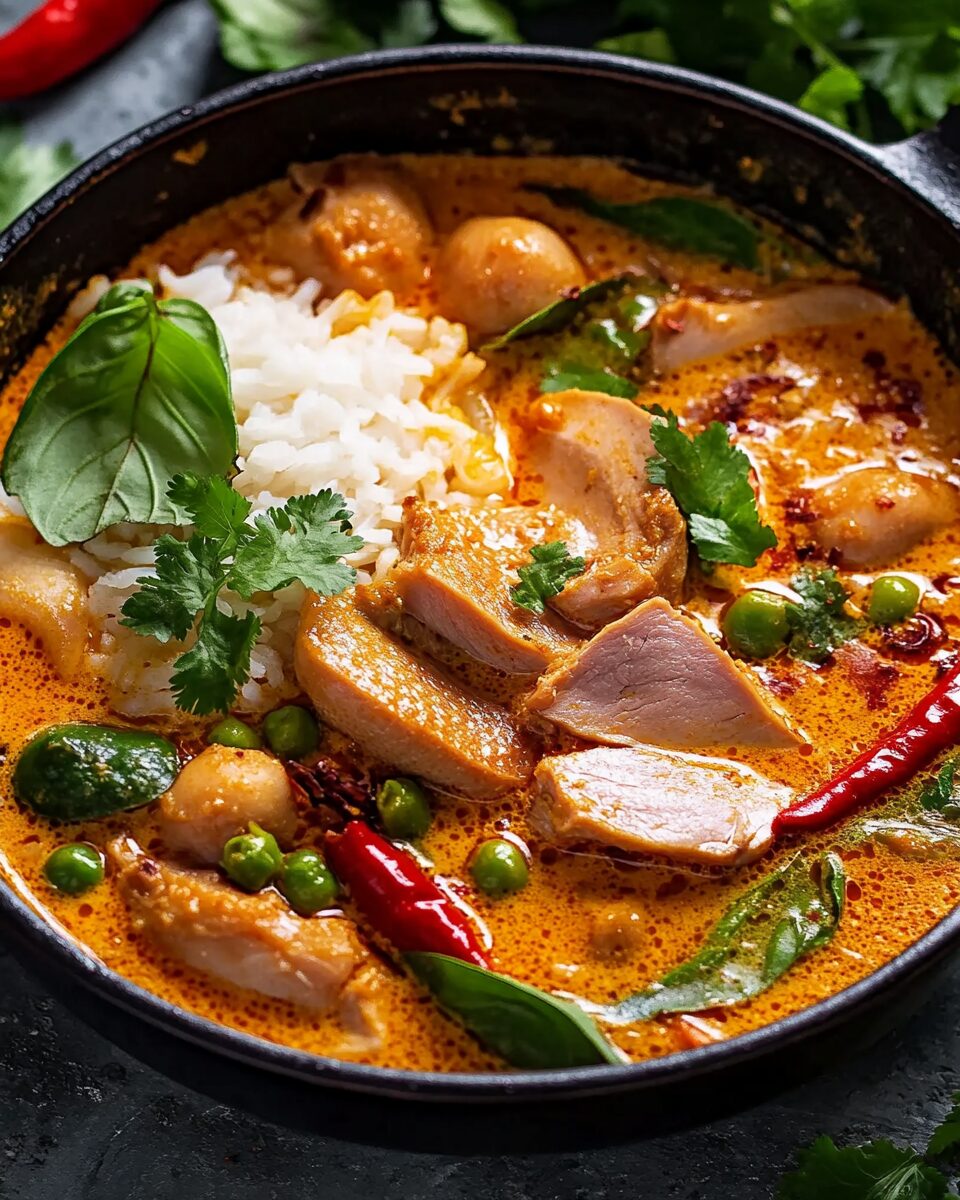The fusion of rich, juicy duck breast with the bold flavors of Thai red curry creates a dish that feels both indulgent and balanced. Sweet bursts from lychees or pineapple dance in the spicy, creamy coconut sauce, making each bite a celebration of contrast.
A true showstopper, this Thai Red Duck Curry transforms your kitchen into a five-star Thai restaurant. Whether you’re hosting guests or just treating yourself, this meal delivers deep, aromatic flavors and a sense of luxury with minimal fuss. Don’t be surprised if it becomes your go-to dinner party flex.
Full Recipe:
500g (1 lb) boneless duck breasts, skin on (approx. 3 pieces)
1/4 tsp kosher salt
1/4 tsp white pepper
2 large garlic cloves, finely grated
2 tsp fresh ginger, finely grated
115g (1/2 cup) Thai red curry paste (Maesri recommended)
1 cup low-sodium chicken stock
400ml (14 oz) full-fat coconut milk
6–8 makrut lime leaves, crushed
2 tsp fish sauce
2 tsp white sugar
120g (4 oz) green beans, trimmed and halved
8–12 lychees, fresh or canned (or 1 1/4 cups pineapple pieces)
1 cup Thai basil leaves, lightly packed
Jasmine rice, for serving
Extra Thai basil, coriander leaves, red chili slices, lime wedges for garnish
Directions:
Preheat oven to 180°C/350°F (160°C fan-forced).
Score the duck skin diagonally without cutting into the flesh. Pat dry and season both sides with salt and pepper.
Place duck skin-side down in a cold, oven-safe pan. Place another pan on top to weigh it down. Turn heat to medium-low and cook for 10 minutes until golden and crispy, rendering the fat.
Flip and cook flesh side for 1 minute. Transfer to oven and roast for 8 minutes (target internal temp: 60°C/140°F for medium). Let rest for 5 minutes.
In a skillet, heat 2–3 tbsp of rendered duck fat over medium heat. Sauté red curry paste, garlic, and ginger for 4–5 minutes until darkened and fragrant.
Add chicken stock, simmer to reduce by half. Stir in coconut milk, lime leaves, fish sauce, and sugar. Simmer for 2 minutes.
Add green beans, simmer for 3 minutes until just tender. Add lychees or pineapple, simmer for 1 minute. Stir in Thai basil and remove from heat.
Slice duck into 5mm thick pieces. Spoon some curry sauce into a bowl, lay duck slices on top, then spoon more sauce around. Garnish with fresh herbs, chili slices, and lime wedges. Serve with jasmine rice.
Prep Time: 15 minutes | Cooking Time: 30 minutes | Total Time: 45 minutes
Kcal: 435 kcal | Servings: 4–5
The Allure of Thai Red Duck Curry
Thai Red Duck Curry is more than just a meal — it’s an experience that blends the richness of duck with the bold, fragrant notes of classic Thai red curry. Known as Gaeng Phed Ped Yang in Thai, this dish is considered a luxurious and festive option in Thailand, traditionally served on special occasions or in high-end restaurants. However, with access to quality ingredients and a bit of culinary curiosity, it’s surprisingly achievable at home.
The magic of this curry lies in its contrasts. The rich, fatty duck meat is paired with a spicy, creamy red curry sauce, and the whole dish is brightened by sweet fruit like lychees or pineapple, fresh herbs, and often green vegetables. Every spoonful hits your taste buds with layers of heat, sweetness, umami, and herbaceous freshness — a true celebration of Thai culinary harmony.
Why Duck is the Star of the Show
Duck meat is revered in many cuisines for its distinctively rich flavor and succulent texture, and in Thai cooking, it’s often reserved for more decadent or celebratory dishes. Unlike chicken or beef, duck offers a robust and gamey flavor that pairs exceptionally well with the creamy, spiced complexity of red curry.
In this recipe, duck breast is used — skin-on and boneless — pan-seared until golden and finished in the oven. This method not only renders out much of the fat but also gives a deliciously crispy skin that elevates the dish to another level. Cooking the duck to medium or medium-rare ensures a juicy texture that doesn’t get lost when paired with the thick curry sauce.
The Power of Thai Red Curry Sauce
Red curry is one of Thailand’s most iconic curry bases. Made from dried red chilies, garlic, lemongrass, galangal, shallots, and a variety of spices, it offers a moderately spicy, deeply aromatic base that’s both vibrant and smooth. When blended with rich coconut milk and balanced with fish sauce and sugar, it becomes a sauce that is complex, comforting, and endlessly versatile.
In this duck curry, the sauce is enhanced with makrut lime leaves for an earthy citrus note, garlic and ginger for warmth, and basil for a pop of freshness at the end. Cooking the curry paste in rendered duck fat is a chef’s trick that adds another layer of richness and flavor depth.
Balancing Sweet and Savory with Fruit
What makes Thai Red Duck Curry so unique and visually stunning is the addition of fruit. Lychees are often the preferred choice for their delicate sweetness, juicy texture, and striking appearance. That milky-white orb with a subtle perfume works harmoniously with the heat and creaminess of the curry, offering bursts of sweetness in every bite.
If lychees aren’t available, fresh or canned pineapple is an excellent substitute. The natural acidity of pineapple helps cut through the richness of the duck and the sauce, balancing the dish beautifully. This element of sweet fruit in a savory curry may be unusual to some, but it’s a hallmark of Thai cuisine’s fearless blending of flavor profiles.
Thai Basil and Other Fresh Finishes
Herbs are crucial in Thai cooking, not just for garnish but for their aromatic contributions. Thai basil, with its aniseed undertone, adds a uniquely Southeast Asian character to the dish. It’s more pungent and peppery than sweet basil, and when stirred in just before serving, it brings a fresh, almost minty pop that lightens the heavy flavors.
Coriander (cilantro) and sliced red chili peppers can also be added as finishing touches. Not only do they add color contrast, but they contribute an additional fresh bite and a bit of extra spice for those who crave more heat.
What to Serve with Thai Red Duck Curry
As with most Thai curries, jasmine rice is the ideal accompaniment. Its soft, floral aroma and neutral taste make it the perfect canvas to absorb the rich, bold curry sauce. For a more modern presentation, you could also pair the curry with coconut rice or even sticky rice, though traditionalists might raise an eyebrow.
For side dishes, consider a refreshing Thai cucumber salad or a simple stir-fried vegetable dish with oyster sauce. These sides offer a cooling contrast to the spice and fat content of the duck curry and help round out the meal.
Common Variations and Ingredient Swaps
This recipe is fairly flexible, and many home cooks like to adapt it based on availability or dietary needs. Here are a few popular variations:
Vegetable substitutions: Green beans are a colorful, crisp addition, but you can use snow peas, baby corn, or even cherry tomatoes. Just be mindful of cook times to maintain their texture.
Fruit options: If you can’t find lychees or pineapple, try mango chunks or even peeled grapes for a sweet, exotic twist.
Protein swap: For a more affordable or accessible version, chicken thighs or even tofu can be used, though the dish will lose the distinct luxury feel that duck provides.
Curry paste: Homemade red curry paste is ideal, but quality store-bought versions like Maesri are convenient and authentic in flavor. You can also add more chili paste or chili oil for extra heat.
Cultural Significance and Restaurant Inspiration
Thai Red Duck Curry is often featured in upscale Thai restaurants, where it’s presented with flair and served as the highlight of the meal. It’s considered a luxurious offering, partially because of the cost and perceived opulence of duck meat, and partially because of the care needed in preparation.
This particular recipe was inspired by a dish served at a popular Thai eatery in Sydney, Australia, called Khao Pla. The chef’s take on it captured all the components of a memorable Thai dining experience — succulent duck, perfectly balanced sauce, and a presentation that invited compliments before the first bite.
Tips for Perfecting the Dish at Home
Making Thai Red Duck Curry at home may sound intimidating, but it’s all about smart workflow and good timing. Here are a few tips:
Render the duck fat slowly: Start with a cold pan and low heat. This allows the fat to slowly render, resulting in extra crispy skin without overcooking the meat.
Cook the curry paste: Don’t skip this step. Sautéing the paste in duck fat boosts flavor immensely and prevents a raw or flat-tasting sauce.
Balance your flavors: Thai cuisine is about the perfect balance of sweet, salty, spicy, and sour. Taste as you go and don’t be afraid to adjust fish sauce, sugar, or lime juice at the end.
Use fresh herbs: Dried herbs won’t cut it here. The aroma of fresh Thai basil is irreplaceable, and it gives the dish that final authentic touch.
Conclusion: A Dish Worth Mastering
Thai Red Duck Curry is a masterclass in culinary contrast — luxurious yet approachable, spicy yet sweet, and bold yet refined. While it might take a little more effort than your average weeknight meal, the payoff is enormous. From the moment you present the dish, with its glistening duck slices, vibrant curry sauce, and aromatic herbs, you’re delivering an experience, not just dinner.
It’s the kind of recipe that impresses guests, elevates your weeknight rotation, and most importantly, connects you to the rich tapestry of Thai flavors and traditions. Whether you’re a seasoned cook or a curry enthusiast looking to try something new, Thai Red Duck Curry deserves a place in your kitchen repertoire.
Let it be your next dinner centerpiece — one that leaves your kitchen smelling divine and your guests asking for seconds.






